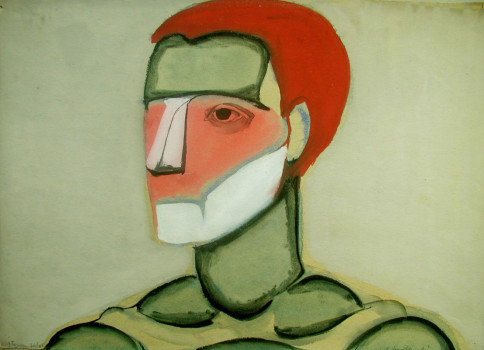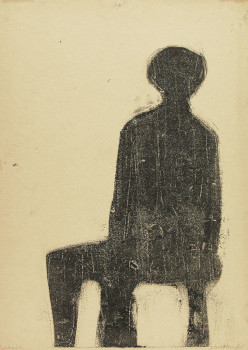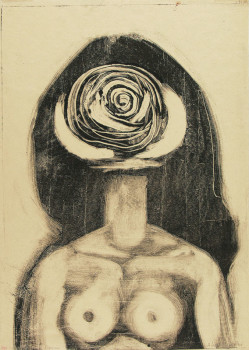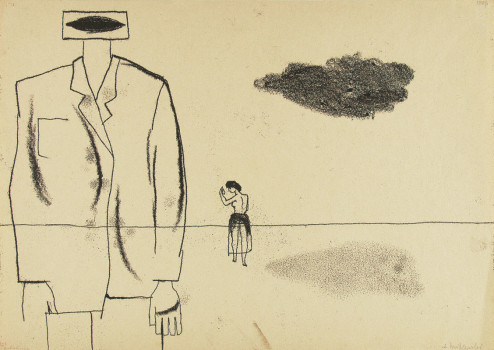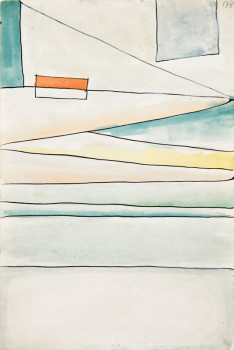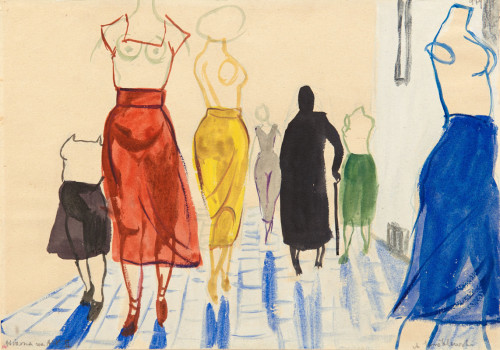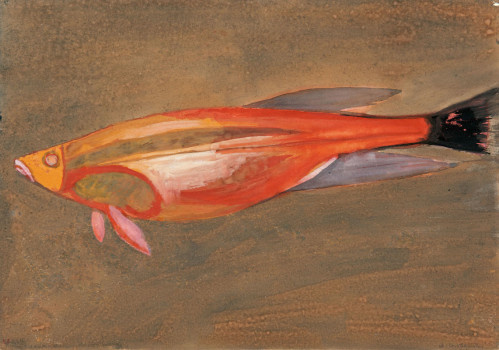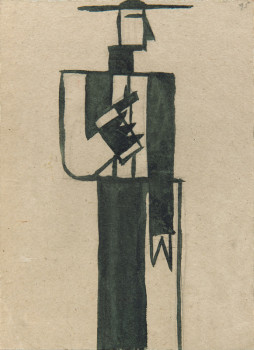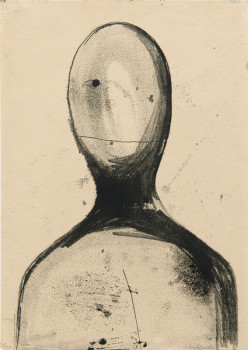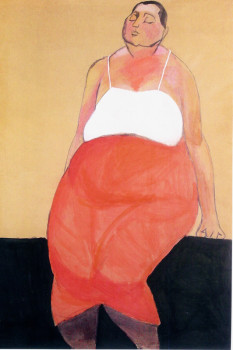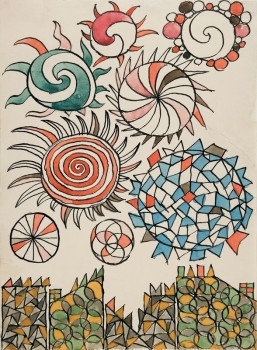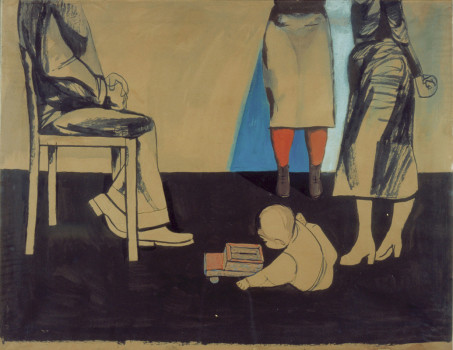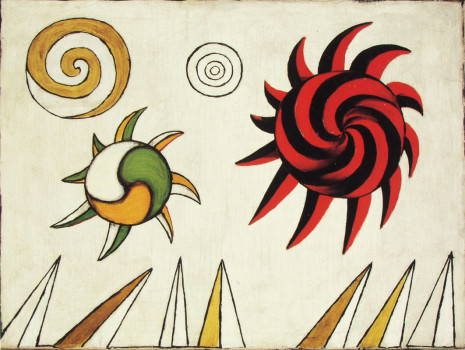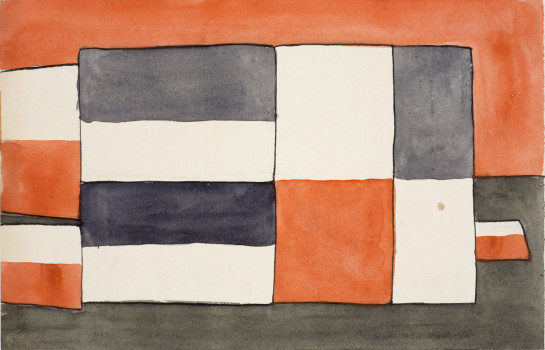14.10.2016 - 26.03.2017
01.02.2014 - 29.03.2014
06.09.2011 - 05.11.2011
1927
born in Vilnius, Lithuania
1957
died in Tatra
2017
documenta 14, Athens (GR) / Kassel (DE)
2015
ANDRZEJ WRÓBLEWSKI: RECTO / VERSO 1948–1949, 1956–1957 Museum of Moder Art, Warsaw, Poland
ANDRZEJ WRÓBLEWSKI: RECTO / VERSO, Palacio de Velázquez, Museo Reina Sofia, Madrid, Spain
2014
DE.FI.CIEN.CY – Andrzej Wróblewski, René Daniëls, Luc Tuymans, curated by Ulrich Loock, Art Stations Foundation by Grazyna Kulczyk (in cooperation with Galerie Isabella Czarnowska, Berlin), Poznan, Poland
2013
Andrzej Wróblewski – From Within / From without, International symposium about Andrzej Wróblewski’s life and work, Museum of Modern Art Warsaw, Warsaw, Poland
Map. Artistic Migrations and the Cold War. Group exhibition. Zacheta National Gallery of Art, Warsaw, Poland
2011
Andrzej Wróblewski: A Barbarian in the Garden, Paintings 1948 – 1957, Galerie Isabella Czarnowska, Berlin, Germany
Side by Side: Poland – Germany. 1000 Years of Art and History, group exhibition, Martin-Gropius-Bau, Berlin, Germany (catalogue)
2010
Andrzej Wróblewski: To the Margin and Back, Van Abbemuseum, Eindhoven, Netherlands
The Reality of The Lowest Rank – Vision of Central Europe, curated by Luc Tuymans, Bruges, Belgium (The exhibition showed very important paintings by Wróblewski next to Alina Szapocznikow, Tadeusz Kantor and others)
2007
Andrzej Wróblewski, 1927-1957. Muzeum Narodowe w Warszawie, Warsaw, Poland (catalogue)
2004
Przeksztalcenia. Andrzej Wróblewski 1956-1957, Panstwowa Galeria Szituki, Warsaw, Poland (catalogue)
1998
National Museum, Kraków, Poland (catalogue)
1995
Zacheta National Gallery of Art, Warsaw, Poland (catalogue)
1994
Zderzak Gallery, Kraków, Poland
1967
National Museum, Poznan, Poland
1958
The Palaise of Art, Kraków, Poland
Biography
1957
Wróblewski produced several versions of portraits of a model from the Academy: Head with Letters [Glowa z literami], Head of a Man [Glowa mezczyzny] and Head on Red Background [Glowa na czerwonym tle]. He also prepared a number of images of a man sitting on a stool or a bench: the oil painting Man on a Bench [Mezczyzna na lawce] and gouache Man [Czlowiek], which led to the outstanding Organic Portrait [Portret organiczny], a work unique in Polish art. At the same time the artist worked on paintings that stylistically continued the ‘torn men’ theme: Woman [Kobieta] and Shadow of Hiroshima [Cien Hiroszimy].
Wróblewski made eighty-four monotypes on paper in various sizes, approx. 30 x 20 cm and 30 x 42 cm (some forty of which are publicly known today), in which he revisited themes found in his earlier work including: Fish [Ryba], Fish with Letters [Ryba z literami], images ofwomen: Nude [Akt], Female Torso [Tors, kobiety], Girl [Dziewczyna), Bust [Popiersie], various versions of the torn, crippled man: Organic Portrait, Stumps [Kikuty], tombstones: Tombstones [Nagrobki], Cemetery [Cmentarz], as well as Face [Twarz], Woman-Death [Kobieta- smierc], Meeting [Spotkanie], Transformations [Przeksztalcenia], Flower Pot [Doniczka], Violin [Skrzypce] or Ambulance [Karetka pogotowia].
At the 23rd of March the artist died during a solitary hike in the Tatry mountains. His death is surrounded by a sense of mystery. Most likely Wróblewski collapsed and fell during an epileptic seizure, as a result of which he died of hypothermia.
1956
The year marked a time of intense and fruitful painterly practice. Some thirty oil paintings and several hundred works on paper, which developed the themes of the oil paintings, date from that period. The artist also created series devoted to specific themes mainly using gouache. At the beginning of the year Wróblewski produced a number of images of lost, lonely boys in empty interiors: Boy on Yellow Background [Chlopiec na zóltym tle], Boy [Chlopczyk]. In January and February, the artist painted three well-known portraits of Ola Peterstein, a model from the Kraków Academy, titled: Head of a Model I [Glowa modelki I], Head of a Model II [Glowa modelki II] and Head of a Model III [Glowa modelki III]. Wróblewski also returned to the themes found in his early work from the years 1948 – 1949.
In August Wróblewski worked on a large canvas Chauffeur [Szofer], which took up the theme of the Blue Chauffeur [Szofer niebieski]. In this year (as well as early in 1957) the artist produced numerous gouaches depicting interiors of buses driven with lone drivers: Chauffeur, Chauffeur with a Winter Landscape, [Szofer z zimowym pejzazem], Chauffeur in a Bus [Szofer w autobusie], Chauffeur und Passengers [Szofer i pasazerowie].
Wróblewski completed his significant works: Laundry [Pranie], and perhaps the best-known canvas The Queue Continues [Kolejka trwa], Chairing l and ll [Ukrzeslowienie I, II], Chairs [Krzesla], as well as thematically convergentworks on paper: several versions of The Queue Continues, or those which formally refer to the ‘chairs’ series: Flirting Chairs [Krzesla flirtujace], Chairs [Krzesla] or Chaired Woman I and ll [Ukrzeslowiona I, II].
The gouaches address a number of themes: torn man / heads and skulls / hands and mouths / man of stone / Zampano – works depicting the character of Fellini’s La Strada / images of horses / imaginary landscapes / barges / cars.
The artist also explored the technique of collage, producing four works.
In February as a result of the help of Andrzej Wajda, the artist’s first solo exhibition was mounted in Warsaw’s Club of the Polish Writers’ Union. The exhibition featured thirty-six works on paper. These were mainly ink illustrations to Apollinaire’s The Hills produced in 1954, and to Lorca’s Rosita, as well as others, e.g. Elysian Fields [Pola Elizejskie], Drunkards [Pijacy] and Rooftops [Dachy]. The first exhibition was accompanied by a short introductory note written by the artist and later reprinted in the catalogue of his first posthumous exhibition in 1958.
In September another exhibition of Wróblewski’s painting opened as part of the 3rd Discussion Exhibition of the “Po Prostu” Visual Arts Salon in Warsaw’s Jewish Theatre. The presentation was organised as a result of efforts by the painter Marek Oberländer (1922-1978) who was connected with the ‘thaw period’ weekly “Straight Forward” [Po Prostu]. Amongst others the artist exhibited the following canvases: Focused Portrait [Portret skupiony], The Queue Continues, Chairing and Laundry. The exhibition met with considerable interest on the part of the press and the critics.
30 October – 23 November, Wróblewski, accompanied by Barbara Majewska, set out on a trip to Yugoslavia. They stayed in Belgrade, Ljubljana and Skopje. The artist visited numerous exhibitions and museums, amongst them the studio of Ivan Meštrovic, Croatian-born sculptor, who emigrated to the United States in 1947. Meštrovic is known for his boldly cut figurative monuments and reliefs. Wróblewski met the founders of the group of young artists The December Group [Decembarska grupa] such as Aleksandar Lukovic and Zoran Petrovic. Wróblewski was deeply impressed by the country and its art, copying into his notebook some of the works he encountered, such as Meštrovic’s crucifixions. Fascinated by Serbian stone tombstones, he painted The Tombstone of a Womanizer [Nagrobek kobieciarza] as well as a number of gouaches: Tombstone-Woman [Kobieta-nagrobek], Red Tombstone [Nagrobek czerwony] and Tombstone on Green Background [Nagrobek na zielonym tle].
1955
Early in this year Wróblewski created gouaches that refer to sports themes, mainly women’s track and field athletics: Women Gymnasts [Gimnastyczki], Women Archers [Luczniczki], and Fencing [Szermierka]. In the autumn he prepared illustrations for the poem Rosita by Federico Garcia Lorca and drawings for the poetry of Tadeusz Rózewicz (b. 1921).
Wróblewski also produced oil paintings that focused on the theme of a woman: Nude Woman Seen from Behind [Akt kobiety stojacej tylem], Portrait of a Hunchbacked Woman on Red Background [Portret garbatej z czerwonym tlem], Hunchback Woman [Garbuska], Beach [Plaza], Young Mother with a Child [Mloda matka dzieckiem], Mothers [Matki], Mother (Matka], as well as still lifes Still Life with Folder [Martwa natura z teczka], and landscapes Landscape with High Sky [Pejzaz z wysokim niebem], Landscape – Rooftops in the Rain [Pejzaz-dachy w deszczu]. Two canvases made that year, which are visibly different in terms of style, could be seen as marking the return to the artist’s own painterly explorations, these are Attention, Here It Comes! [Uwaga, nadchodzi! ] and Mothers. The latter was painted for the Polish Exhibition of Young Art in Warsaw’s Arsenal, held under the slogan “Against the War, Against Fascism”. Forty honourable mentions were awarded during the exhibition, however, Wróblewski’s painting failed to meet the jury’s expectations.
Wróblewski was presented with the medal of the 10th anniversary of the People’s Republic of Poland.
At September the 24th the artist’s twin daughters Marta and Krystyna were born. The growth of the family led to a deterioration in material conditions.
1954
Wróblewski made the oil painting Break at Work in Nowa Huta [Fajrant w Nowej Hucie], an account of the plein-air workshops in the summer of 1953 and one of the artist’s finest socialist realist works. He also prepared a series of views across the rooftops of Kraków seen from a window of the Fine Arts Academy (a number of oil paintings and several works in ink), and he created gouaches and drawings that accompanied Apollinaire’s writing.
At May the 10th Wróblewski’s first son, named after his father, also known as Kitek, was born. Soon both the colour and subject matter of his works changed drastically. New works were primarily still lifes in bright hues: Still Life with a Drawing [Martwa natura z rysunkiem], Peonies [Piwonie], Flowers [Kwiaty], MyShoes [Moje buty]. There are many representations connected with motherhood: Scales for Children [Waga dziecieca], Woman Feeding by a Balcony [Karmiaca przy balkonie] and several dozen sketches of his wife and son.
The famous note entitled To Be or Not To Be in the Polish United Worker’s Party [Byc czy nie byc w PZPR] is dated this year.
1953
Wróblewski produced socialist realist canvases including: Union of Polish Youth Takes Command of the Airforce [Zwiazek Mlodziezy Polskiej obejmuje szefostwo nad lotnictwem], Russian Partisan [Partyzant radziecki] and Bloody Sunday 1905 [Krwawa niedziela 1905 ], as well as, during a month long holiday with plein-air workshops in Waganowice, four landscapes and several dozen works on paper. He also prepared his last woodcut, the only one in his mature œuvre, titled Farewell [Rozstanie], which depicts the artist and his wife.
Wróblewski created two series of works in ink: several works Flood in the Netherlands [Powódz w Holandii], which he presented at the 1st Polish Satirical Exhibition, whilst in March the artist made seven ink works under the common heading Mourning News [Smutne wiesci], which illustrates people’s reaction to the news of Joseph Stalin’s death (3 March).
In June, during a plein-air workshop in Nowa Huta, the artist prepared several works that show the construction of a massive steel plant on the outskirts of Kraków.
The artist took part in the exhibition accompanying the 4th World Festival of Youth and Students in Bucharest. He presented the painting At the Meeting [Na zebraniu], for which he received a prize and an honourable diploma when he returned to Warsaw (19 September).
On September 19th Andrzej Wróblewski married Teresa Reutt in Kraków.
1952
Wróblewski’s painterly output was still sparse. Through the year the artist produced eight oil paintings and sketches.
At a holiday stay in Czchów in August, he met his future wife Teresa Reutt (1927-1994), a student of classical philology and history at the Jagiellonian University.
Towards the end of the year he began to work on a painting which related to the events in Vilnius eleven years earlier when Wróblewski witnessed his father’s death: Search – Arrest [Rewizja – aresztowanie]. He continued to work on the piece in February and March of the following year.
1951
The Self-Educational Group was disbanded. Wróblewski failed to communicate with other members. For the second time the artist applied for three-year’s of postgraduate studies in the USSR – again the application was rejected. Between 5 and 18 August Wróblewski stayed in Berlin, where he participated in the 3rd World Festival of Youth and Students. During the stay he made a number of sketches in ink. In relation to these, Wróblewski created his largest oil painting in October , 190 x 270 centimetres in size, titled Youth Rally in West Berlin [Zlot mlodziezy w Zachodnim Berlinie] – the canvas, purchased by the Ministry of Culture and Art, depicts a clash with police forces entering West Berlin on 15 August 1951.
On the 6th of December Wróblewski graduated from the Painting Department of the Academy of Fine Arts, however, his graduation certificate bears the date 22 November 1952.
This year, apart from the monumental Berlin canvas the artist painted Raymond Dien – Stopping of a Train Transport of Weapons to Korea [Raymond Dien – powstrzymanie pociagu wiozacego bron do Korei] and three landscapes.
1950
Only eight oil paintings date from this year, chiefly monochrome portraits and nudes (Portrait of a Man [Portret mezczyzny], Woman Nude Sitting [Akt kobiety siedzacej] and Study of a Male Nude [Studium aktu mezczyzny] ), which resemble sketches or student exercises. They testify to a regression in the artist’s practice and an attempt at confirming the official developments of socialist realism.
Wróblewski also developed a number of prints, amongst others: lithographs National Front [Front Narodowy], Three Colleagues [Trzech kolegów].
In May Wróblewski worked towards obtaining a scholarship for postgraduate studies in easel painting and lithography in the USSR. In spite of positive recommendations from the dean of the Academy and other bodies, Wróblewski’s application was rejected.
Amongst the artist’s loose notes from the period is a list of works for the scheduled thematic exhibition focusing on war and the initial years that followed: An exhibition (some 20 – 30 paintings) on the following subject: the Second World War und the years [19]45 – [19]46. Part 1: war (executions), part 2: the post-warperiod (social contrasts).
For the exhibition The Youth Struggles for Peace [Mlodziez walczy o pokój] held in Warsaw’s National Museum, Wróblewski submitted three works: Nude [Akt], Meeting of the Union of Polish Youth Activists [Zebranie aktywu ZMP] and After the Parade [Po pochodzie].
In the academic year 1950-1951, Wròblewski became an assistant at the Academy, a position he occupied for four years.
On the 20th of December Wróblewski became a candidate of the Polish United Workers’ Party [PZPR] at the Academy of Fine Arts in Kraków. The Municipal Committee of PZPR in Kraków issued him with a candidate membership card with the number 0359433.
1949
The first months brought paintings which addressed the theme of wartime trauma: Wróblewski finished Execution VI (Execution with a Gestapo Man) [Rozstrzelanie z gestapowcem] – painted on 16 – 18 January, Execution VII (Surrealist Execution) [Rozstrzelanie surrealistyczne] – 30 January – 2 February, Execution I (Execution of Hostages) [Rozstrzelanie zakladników] – 22 – 26 February, Mother with a Dead Child [Matka z zabitym dzieckiem] – 13 – 16 March, Execution III (Execution of a Family) [ Rozstrzelanie rodziny] – 14 – 16 March, Child with Dead Mother [Dziecko z zabita matka] – 17 – 18 March, Execution V (Execution with a Boy) [Rozstrzelanie z chlopczykiem] – 5 – 12 April, Execution IV (Execution Against a Wall) [Rozstrzelanie na scianie] – 18 – 20 May The Liquidation of the Ghetto [Likwidacja getta] – 20 – 24 May, Execution VII [Rozstrzelanie VII] 25 – 30 May, Husband Killed in a War [Maz zabity na wojnie] (exact date of completion unknown), and The’Poznan’ Execution [Rozstrzelanie „poznanskie”] – 29 July – 4 August.
The second series of works produced that year consists of four paintings that focus on the issue of social contrasts: Waiting Room – the Poor and the Rich [Poczekalnia-biedni i bogaci] – 10 – 13 August, Two Married Women [Dwie mezatki] – 17-19 August, Shopkeeper [Sklepikarz] -15 – 18 September, and Sieg, Heil! – 18 – 21 September.
Other oil works from the year include the first illustrations of a young couple created in a Chagallesque manner, which would reappear later in Wróblewski’s œeuvre: The Walk of the Lovers [Spacer zakochanych] – 18 – 22 January, Young Couple with a Bouquet [Mloda para z bukietem] – 25 – 29 January, finished between 18 – 21 February, the first oil Self-Portrait -15 – 17 May and the Train Station in the Recovered Territories [Dworzec na Ziemiach Odzyskanych] – 10 – 15 September, where the artist portrayed his colleagues, amongst them Adam Hoffmann (1918-2001) and Andrzej Strumillo.
In July the artist asked for re-admittance to Kraków’s Academy. The application was granted. During the academic year 1949-1950 Wróblewski frequented the studio of Professor Hanna Rudzka-Cybisowa, the first woman to be appointed professor of the Academy, who also represented the kapizm genre.
In that period the Self-Educational Group developed an idea for a major exhibition. With this in mind, its members established contact with similar students’ organisations from Lódz and Poznan. The joint exhibition was to serve as a form of protest and a struggle for socialist realism and progress.
From the 23rd until the 28th of October the Self-Educational Group submitted seven paintings to the Polish Festival of Art Schools in Poznan [Festiwal Szkól Artystycznych], which was to lead to a ‘reform’ of artistic education. A separate exhibition organised by the group included two works by Andrzej Wróblewski: Train Station in the Recovered Territories painted on the back of the abstract composition Emotional Content of the Revolution, which referred to the journeys of repatriates returning from areas that constituted the eastern borderlands of pre-war Poland, but were incorporated into the Soviet Union after 1945. The second work was the only painting from the Execution series exhibited in the artist’s lifetime, the ‘Poznan´ Execution.
The works of the Group met with disapproval and their authors were labelled as ‘neo-barbarians’. The failure of the exhibition and the criticism levelled at the painters forced Wróblewski to publish the so-called self-criticism in 1950:
The self-criticism of the team looks as follows: the key theoretical and practical error consisted in overemphasising the issue of form in contrast to ideological content. (…) Further error – as far as the preparation of the exhibition is concerned – consisted of misinterpreting the issue of war. As far as the theme is concerned, our exhibition eventually failed to form a whole with a distinct ideological line – it was dominated by pessimism and the horrors of war causing fright. (… ) On the other hand, the errors of the Kraków team stemmed largely from the narrow character and one-sidedness of the group. The same goes for the programme and system of institutions of artistic education; at a point where a more general reform is required the festival clearly exposed the aimlessness of one-off, partisan-like cicanges. The festival led to an agreement between a grassroots student initiative with the works and plans of the Ministry.
1948
Wróblewski completed his MA thesis, titled The Origins of Landscape Painting in Netherlandish Art from the 15th to 17th Century, in art history. The work was highly marked by the leading professor and Wróblewski was offered the position as assistant, a proposal he eventually declined. Following the holiday break Wróblewski applied for a year off from the Academy from 1948 to 1949 and was granted leave. His application was accompanied by a doctor’s certificate attesting to his poor health. Throughout the year he submitted a number of articles and reviews to the press.
Amongst others, he saw films Casablanca by Michael Curtiz and Last Stage [Ostatni etap] (1947) by Wanda Jakubowska – a semi-documentary feature film telling the story of the martyrdom of Polish women in Auschwitz and the heroism of prisoners fighting for their dignity.
Towards the end of the year Andrzej Wróblewski officially made known his artistic views and opinions on the educational system at the Academy, as well as on the direction in which Polish post-war art had been developing. A considerable number of the artist’s statements in the press, his notes and conversations with his colleagues from the Academy, testify to the fact that Wróblewski was convinced of a need to change the system. In his articles, he voiced a negative attitude to the current form of artistic education and the aesthetics presented by the professors at the Academy. He launched an open attack on the kapizm movement.
In October along with Andrzej Wajda, Witold Damasiewicz), Konrad Nalecki, Andrzej Strumillo, Przemyslaw Brykalski, Ali Bunsch and Barbara Gasiorowska, the artist founded an informal Self-Educational Group. The group did not have a regular membership; most of its members had belonged to the Union of Polish Youth [Zwiazek Mlodziezy Polskiej].
In December the 1st Exhibition of Modern Art opened to the public at Kraków’s Palace of Art of the Association of Friends of Fine Arts [TPSP]. Wróblewski participated in the exhibition with the following works: Emotional Content of the Revolution [Tresc uczuciowa rewolucji] (the painting was hung in the hall, above the entrance to the first room ), Painting About the Horrors of War [Obraz na temat okropnosci wojennych] (produced specially for the exhibition), Sunken City II [ Zatopione miasto II], Sun and Other Stars [Slonce i inne gwiazdy] and Earth [Ziemia]. The artist also presented spatial models of wood and steel plates. It is likely that he also exhibited a folder with drawings and the painting Sunken City I. On this occasion Wróblewski prepared Commentary on the 1st Exhibition of Modern Art in which he commented on the works in the exhibition, including his own paintings and models. But during the exhibition Wróblewski withdrew from working with Tadeusz Kantor and other artists participating in the show.
In the second part of the year the artist painted amongst others: Geometrical Abstraction in Grey [Abstrakcja geometryczna szara], Sunken City II [Zatopione miasto II], Sky Above the Mountains [Niebo nad górami), Blue Chauffeur [Szofer niebieski] and Biological Abstraction [Abstrakcja biologiczna].
1947
At the 27 of February Wróblewski applied for and was granted a leave of absence at the university. In March he set out on the first of two journeys that proved crucial for his later work. Along with a group of students from the Academy of Fine Arts in Warsaw and Kraków, he left for a three-month scholarship in the Netherlands as part of an exchange organised by World Student Relief.
He extended his stay for another three months. In the Netherlands Wróblewski visited Wageningen, Arnhem, Nijmegen, Leiden, Amsterdam, Utrecht, Rotterdam, Delft, Groningen, Tilburg and The Hague. He also visited Copenhagen, Northern Germany, Sweden and Prague. Fragmentary notes, most of which describe places Wróblewski visited, and reflections on the educational system of the institutions he travelled to, are the evidence of the trip. In Copenhagen, the artist visited, amongst others, the Academy of Fine Arts.
In Amsterdam Wróblewski visited the Rijksmuseum, Stedelijk Museum, Archaeology Museum and Rembrandthuis. It is likely that in the Stedelijk Museum he saw the exhibition of paintings by Marc Chagall.
Also in Amsterdam the group of artists visited the studio of Constant Nieuwenhuys one of the founders of the CoBRA group.
After his return to Kraków the artist had his debut at the exhibition of the Discussion Circle (Kolo Dyskusyjne] in Kraków.
1946
At the Academy Wróblewski initially frequented the painting studio of Professor Zygmunt Radnicki (1945 – 1946) and then moved on to Professor Zbigniew Pronaszko (1946 – 1947), whose practice was related to Polish colourism. This year he created his first oil paintings, most of which, such as Still Life with a Jug [ Martwa natura z dzbanem], or Still Life with Cherries [Martwa natura z wisniami] make overt references to the kapizm of his tutors.
1927 – 1945
Andrzej Krystyn Wróblewski was born on June 15th, 1927 in Vilnius, Lithuania, the second son of Bronislaw and Krystyna Wróblewski. His father was a Professor of law and his mother was a graphic artist. He had an one and half year older brother.
In 1938 he began his education. During the war Wróblewski continued his education through clandestine courses organised out of school.
On 26 August 1941 Andrzej wittnessed a Nazi search of his family house. His father died of a heart attack during the search when he was 14 years old. This incident affected his later work.
Between 1944 and 1945 Wròblewski executed, under the supervision of his mother, a series of
nineteen woodcuts.
In 1945 Krystyna Wróblewska moved to Kraków, along with her sons Jerzy and Andrzej and a group of repatriates from Vilnius. The woodcut Train Station [Dworzec] testifies to the events of this time.
Having moved to Kraków he obtailed his “Mattura” at July 17th. In October he began studies at two departments: Painting and Sculpture at the Kraków Academy of Fine Arts, and Art History at the Jagiellonian University. He also produced 15 woodcuts this year.
Andrzej Wróblewski, un ‘Goya’ polaco en tierra de nadie by Julia Luzán
Lo primero que recibes cuando observas en el Palacio de Velázquez de Madrid las pinturas del polaco Andrzej Wróblewski (Vilna1927-Tatras 1957) es un puñetazo en la cara con sus cuadros de ejecuciones, de los horrores de la guerra, los traumas y las secuelas de la Segunda Guerra Mundial; son obras icónicas como los ‘Fusilamientos’ de Goya o el ‘Guernica’ de Picasso, un grito ante la muerte absurda de quienes deciden arrebatarla.Andrezej Wróblewski es un héroe, un mito nacional en Polonia, pero prácticamentedesconocido en España. Hasta ahora.
...read more on
El Reina Sofía descubre al artista Andrzej Wróblewski, un mito en Polonia by Mila Trenas
Como ocurre con otros artistas centroeuropeos de la postguerra, el polaco Andrzej Wróblewski es un mito en su país y un desconocido fuera de sus fronteras. A él dedica el Museo Reina Sofía una gran retrospectiva en el Palacio de Velázquez del Parque del Retiro.
...read more on
Andrzej Wróblewski, el pintor de las dos caras by ANA BELÉN GARCÍA FLORES
El artista Andrzej Wróblewski (Vilnus,1927, Tatry,1957) es una figura legendaria en Polonia por su compromiso político, y un autor valorado como clave en el relato de los traumas de la posguerra europea, aunque en nuestro país su nombre es prácticamente desconocido
...read more on
El pintor que sobrevivió a Hitler, Stalin y a la abstracción by Peio H. Riano
Andrzej Wróblewski (1927-1957) protagoniza una de esas historias soterradas en los manuales de la Historia del Arte, que aparecen sin avisar como el eco extraviado del pasado. El suyo es el extraño caso del pintor que sobrevivió a la II Guerra Mundial, el estalinismo, se abrazó a la abstracción y al realismo socialista al tiempo.
...read more on
Los cuadros dobles de Andrzej Wróblewski en el Palacio de Velázquez by BLOUIN ARTINFO
La exposición “Andrzej Wróblewski. Verso/reverso”, permite conocer el recorrido artístico y la labor de un artista, centrado en la obra gráfica, pintura y, sobre todo, dedicando una exclusiva atención a uno de los aspectos más esenciales de su corta vida creativa: las pinturas dobles.
...read more on
Andrzej Wróblewski en el Palacio de Velázquez by Antonello Dellanotte
Aunque la expo está montada desde el pasado 17 de noviembre, no fue hasta ayer que me adentré en el Palacio de Velázquez para visitarla. Me hubiera gustado escribir este artículo antes, pero la verdad es que los últimos dos meses, con la producción y el lanzamiento de, unidos a mis habituales quehaceres diarios, lo he tenido que ir posponiendo.
...read more on
Las dos caras de Andrzej Wróblewski by NATIVIDAD PULIDO
Si nos preguntaran el nombre de algún artista polaco, probablemente «pasaríamos palabra». Andrzej Wróblewski es uno de ellos: un tesoro nacional en su país, pero un completo desconocido para el público español. El Reina Sofía, en su afán por descubrirnos esas otras figuras que no arrastran masas a los museos, sino que deambulan, cual funambulistas, por los márgenes de la Historia del Arte, nos desvela laobra incómoda de este artista que nunca se adaptó a ningún canon.
...read more on
El Reina Sofía descubre al artista Andrzej Wróblewski, un mito en Polonia by EFE
Como ocurre con otros artistas centroeuropeos de la postguerra, el polaco Andrzej Wróblewski es un mito en su país y un desconocido fuera de sus fronteras. A él dedica el Museo Reina Sofía una gran retrospectiva en el Palacio de Velázquez del Parque del Retiro.
...read more on
El pintor que se rio del estalinismo by ÁNGELES GARCÍA
El pintor Andrzej Wróblewski decidió el 23 de marzo de 1957 hacer una excursión solitaria por los montes Tatras, al sur de Polonia. Un mal paso bastó para que se escurriera y perdiera la vida. Había nacido en Vilna, en 1927 y solo tenía 29 años.
...read more on
Der große Unbekannte by Sebastian Preuss
Andrzej Wróblewski ist ein Mythos der polnischen Nachkriegskunst, aber außerhalb des Landes kennen bisher nur wenige sein geniales Werk. Eine Ausstellung in Warschau und Madrid sowie eine monumentale Monografie könnnen dies nun änder
...read more on
Nazis, cake and the Wizard of Oz: a drawing show with a difference by Adrian Searle
We are invited to make up stories to connect the disparate, uneasy – and sometimes funny – drawings of Andrzej Wróblewski, René Daniël and Luc Tuymans
...read more on
Trzej artyści próbują malować to, co niemożliwe by Monia Kuc
Nowa wystawa w poznańskiej galerii Art Stations w Starym Browarze w Poznaniu wpisuje twórczość Andrzeja Wróblewskiego w kontekst międzynarodowy
...read more on
DE. FI. CIEN. CY – Andrzej Wróblewski, René Daniëls oraz Luc Tuymans w galerii Art Stations w Poznaniu by Ulrich Loock
Już wkrótce w Art Stations Foundation będzie można zobaczyć wystawę DE. FI. CIEN. CY [Ułomność], na której pokazany zostanie szeroki wybór prac na papierze Andrzeja Wróblewskiego, René Daniëlsa i Luca Tuymansa. Ekspozycja będzie się skupiać się na dziełach Wróblewskiego z lat 1955 – 1957 oraz Daniëlsa i Tuymansa powstających od początku lat 80-tych XX wieku. Prace wypożyczono z kolekcji prywatnych i państwowych z Polski, Belgii, Holandii, Francji, Niemiec i Szwajcarii. Ponadto Luc Tuymans specjalnie na wystawę wykona w galerii rysunek ścienny w dużym formacie
...read more on
Himmelskörper by Katrin Wittneven
Die Galerie Czarnowska entdeckt den polnischen Avantgardisten Andrzej Wróblewski.
Es gibt Ausstellungen, die den Besucher beglücken und gleichzeitig ein wenig beschämen. In der Galerie Czarnowska kann es einem so ergehen, wenn man auf die Werke von Andrzej Wróblewski stößt und feststellen muss, dass man diesen Ausnahmekünstler außerhalb Polens
...read more on
Das doppelte Gewissen der Moderne. Malen zwischen Abstraktion und Sozialistischem Realismus: Andrzej Wróblewski by Eduard Beaucamp
Als vor sechs Jahren die Grenzen nach Osten öffneten und die Epoche der Zwangsherrschaften vorüber war, richteten sich hochgespannte geistige und ästhetische Erwartungen an dei Nachbarn. Manche hofften auf eine Entdeckung abgedrängter und verschollener Künstlergenerationen. Die Wunschträume erfüllten sich nicht
...read more on
Eduard Beaucamp: Der verstrickte Künstler, Dumont Verlag, Köln 1999
Galerieprofil Isabella Czarnowska - Mir liegt die Art so zu denken by Julika Nehb
Nach Stationen in Stuttgart und Köln Mitte der 1980er Jahre führt Isabella Czarnowska seit 2006 unter ihrem Namen ihre Galerie in der Rudi-Dutschke-Straße. Mit 18 Jahren war sie von Polen nach Stuttgart zum Kunstgeschichtsstudium gekommen – an der Fakultät saßen Geisteswissenschaftler mit Studenten der Akademie der Künste in gemeinsamen Veranstaltungen. Wichtige Begegnungen mit Künstlern ergaben sich während einer Romantikvorlesung mit Jean-Pierre Dubost
...read more on
Anrzej Wróblewski, Recto/ Verso, Museo National Centro de Arte Reina Sofia, Madrid, 2015.
Andrzej Wróblewski Recto/Verso, edited by Eric de Chassey & Marta Dziewanska, Museum of Modern Art, Warsaw, 2015 (selection of lectures given at the conference that took place in Museum of Modern Art in Warsaw in September 2013).
Andrzej Wróblewski, Avoiding Intermediary States, Hatje Cantz, Ostfildern 2014.
Andrzej Wróblewski. Constantly Looking Ahead, National Museum in Krakow / Andrzej Wróblewski Foundation, Kraków 2012.
Omilanowska, Malgorzata: Tür an Tür: Polen – Deutschland. 1000 Jahre Kunst und Geschichte, Martin-Gropius-Bau/DuMont Buchverlag, Berlin/Köln 2011, pp. 621-623, 627, 649-651, 665.
Ziólkowska, Magdalena: Andrzej Wróblewski. To the Margin and Back, Van Abbemuseum, Eindhoven 2010.
LUC TUYMANS. The Reallity of the Lowest Rank. A Vision of Central Europe, Vision of Central Europe, Lannoo Publishers, Tielt 2010, pp. 248-255.
Andrzej Wróblewski, with texts by Zofia Golubiew, Anda Rottenberg, Andrzej Wajda et. al., Galerie Sztuki Wspólczesnej Zacheta / Muzeum Narodowe w Krakowie / fundacja Instytut Promocji Sztuki, Warsaw 1998.
